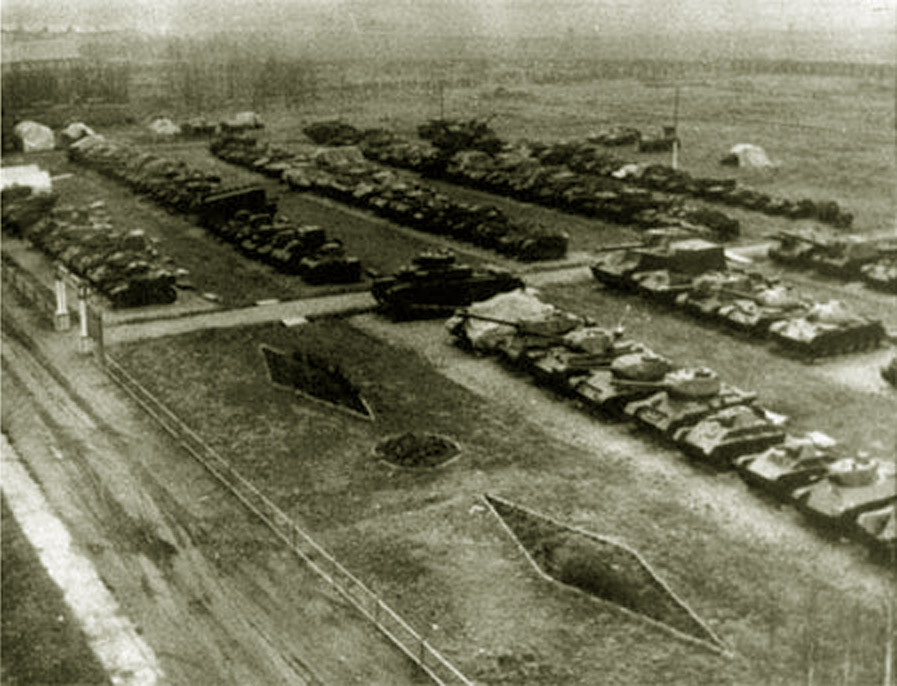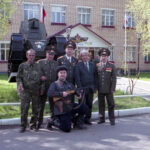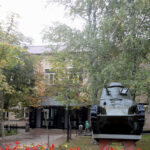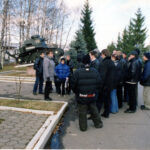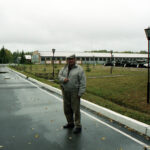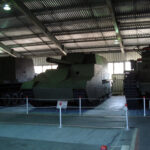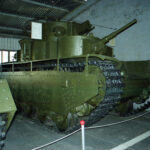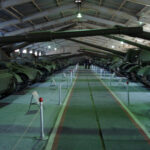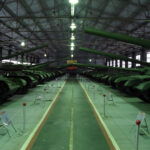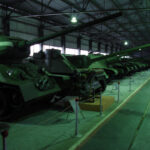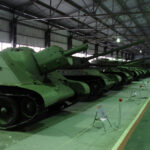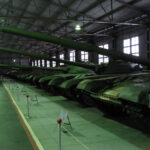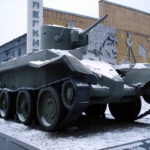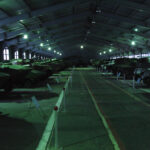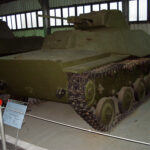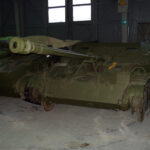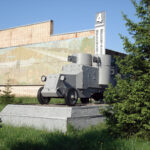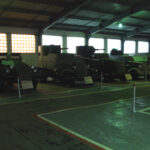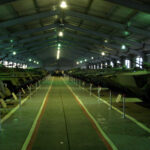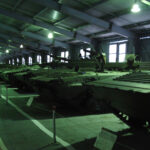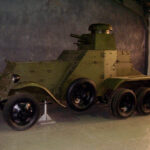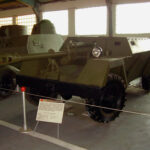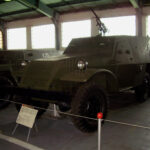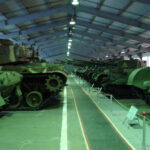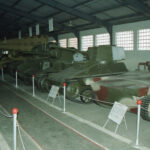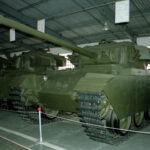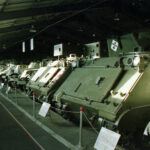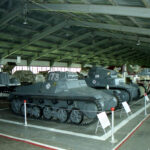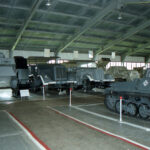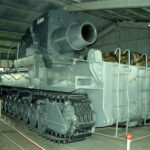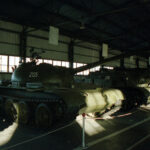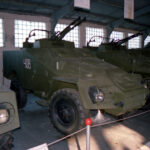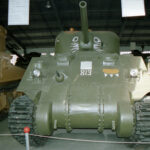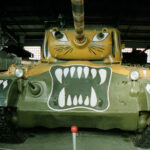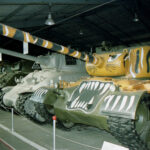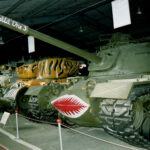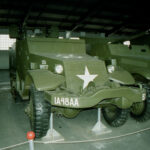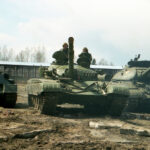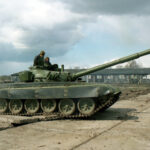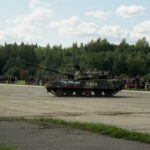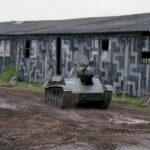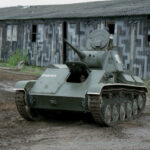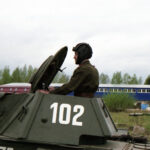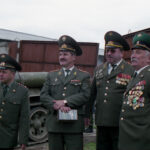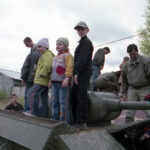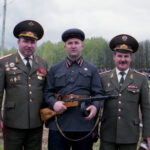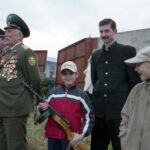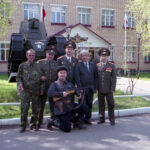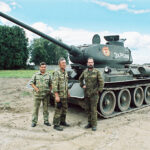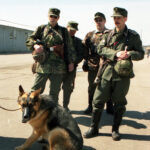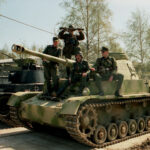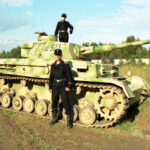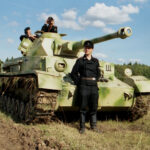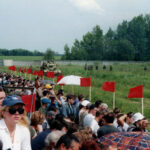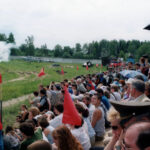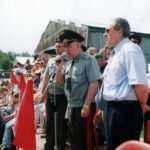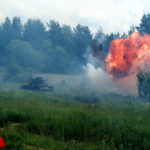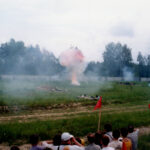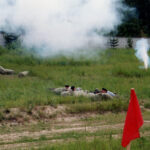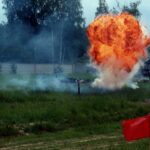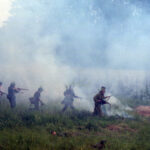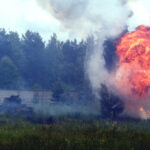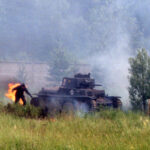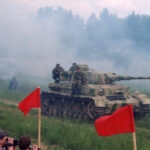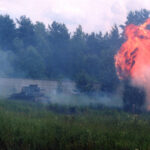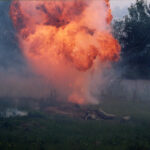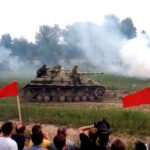A history of the tank museum in Kubinka, from its foundation as a part of a test site in 1931 to its conversion into just a technical repair area of Patriot Park in 2015-2016. For a long time, before certain events in Ukraine, the Saumur tank museum iin the Loire Valley was the “brother and friend” of the Kubinka Tank Museum. The collection of the Saumur Tank Museum contains not only a world-renowned collection of Soviet tanks, but also uniforms from Soviet tankmen of the 4th Guards Kantimirovsky and 2nd Taman divisions. The Museum of the Army of the Invalides in Paris has uniforms of the 45th special forces regiment of the Kubinka Airborne Forces. Below is a guide to the museum and the history of military units in the Kubinka region, as well as a description of the uniforms available in the collection of the Saumur Tank Museum (Loire Valley) and the Invalides Army Museum (Paris).
History of the Kubinka Tank Museum
In 1931, a tank test site was founded a few kilometers south of the Kubinka railway station and the M1 Moscow-Berlin highway. On the western side, near the road to Naro-Fominsk, residential buildings were built for the families of officers, as well as a club. To the east and south there was a reservoir, a test track for tanks including ditches and hills, as well as a shooting range. To the west of the military camp, barracks and an archive were built. The archive was a technical reference library and repository of classified technical documents both domestic and foreign. Near the barracks, on the northern outskirts of the training ground near the Moscow-Minsk-Berlin highway, there was an outdoor area for storing examples of military vehicles.
The first example vehicles at Kubinka were small, medium and heavy tanks built by the Carden-Loyd-Vickers company and purchased from Great Britain in 1930. The first Soviet tanks built on the basis of the French Renault FT-17 and the Vickers samples were also stored here. The tanks were tested at the range, and then remained in storage on the outskirts of the range. In 1938, an official decision was made that all obsolete tanks would remain at the training ground and form a museum collection. For this purpose, Red Army trophies from the Russian Civil War (1917-1923) were sent from the troops to Kubinka, including one large Mk 5 Rhombus tank (Great Britain) and one Renault FT-17 tank (France). The 15 remaining obsolete Mk 5 tanks were installed for propaganda purposes in the cities of Arkhangelsk, Smolensk, Lugansk, and Kharkov. After the capture of these cities by German troops in World War II, some of the tanks were taken to Germany as trophies and their fates are unknown. Skirmishes with Japan in the Far East between 1935-1939 expanded the museum’s collection with captured Japanese trucks, cars and tanks, the fate of which are also unknown.
Two items of particular interest from the 1930s are the American Christie chassis M1931 light tank prototypes covertly purchased in New York, USA as “agricultural tractors” and shipped to the Soviet Union. These were used to develop the Soviet BT (Bystrokhodny) series of high-speed light tanks. These tanks, which without tracks could reach an incredible speed of up to 112 (?140) km / h, were tested on the highway near Kubinka. From the very beginning, these tanks were designed so as to conduct a rapid offensive towards Berlin and Central Europe. To overcome the Buk River on the Soviet-German border, the light amphibious T-40 tank was manufactured by the Stalin Moscow Automobile Plant (ZIS) to complement the BTs. (Is there a T-40 in the collection? Otherwise this sentence is a tangent, remove it.) The capture of the Baltic States by Stalin in 1940 added to the museum’s collection British tanks which were in service with Latvia, Lithuania and Estonia. By the beginning of the Soviet-Finnish (“Winter”) War, a heavy SU-14 self-propelled gun was made on the basis of a British tank to break through the Mannerheim Fortification Line. The complex suspension, adapted from the British example, proved to be very bad in the winter conditions of Russia and Finland. A new, simpler, SU-100Y self-propelled gun with a ship gun was built. Both of these large monsters were used in desperation in the battle for Moscow during the Second World War before becoming a part of the museum’s collection. When the front approached Kubinka, the testing site’s equipment and part of the museum’s collection were temporarily evacuated to the rear. The fate of the remaining exhibits is unknown, including one of the two Christie chassis. In Soviet times, the Museum was surrounded by a restricted zone where it was forbidden to walk and carry out search work. However, it may now be possible to recover some fragments of the pre-war collection in the former restricted forest zone.
World War II and the Collection at Kubinka
The German invasion of the Soviet Union in 1941 made Kubinka’s testing and evaluation programs of vital importance. The Red Army needed guidance on how to best fight and destroy every German vehicle deployed on the Eastern front. The officers at Kubinka put captured Axis examples through testing so as to determine their capabilities, weak points, vulnerabilities, strengths, and weaknesses. For example, determining at what angles and ranges a standard German Pz-III medium tank could be penetrated by a PTRS-41 anti-tank rifle. The knowledge gained was distributed as recommendations and guidelines for combat throughout the Soviet military.
The rapid pace of tank development in World War II further necessitated their work. The German Pz-VI Tiger heavy tank was first captured by the Red Army at the end of 1942 in the battle for Leningrad. Its subsequent evaluation at Kubinka made it possible to issue a special instruction on how to defeat them before the start of the German Operation Citadel offensive (Orel-Kursk Bulge) in July 1943. For the same purpose, a special team of engineers from Kubinka was sent to the Battle of Stalingrad, and then on to the Orel-Kursk Bulge. Detailed reports were drawn up from battlefield surveys on how, from what distance, and with what caliber the new heavy German Tiger tanks and Ferdinand self-propelled guns could be destroyed. The tanks recovered in good condition were sent to Kubinka to study their individual structural elements, and measure their armor, speed, and gunnery. A large exhibition of Axis trophies was arranged in Moscow, in Gorky Park, opposite the Headquarters of the Ground Forces (including the GABTU, the main armored department). Now this complex of buildings is the National Defense Control Center.
A huge role in the victory of the USSR over Nazi Germany was played by the supply of Lend-Lease equipment from the Western allies, especially in the initial difficult period of the war. Even during the famous Battle of Kursk, the Red Army only had T-60 and T-70 light tanks (called “Locust” or “Walnut”) and T-34 medium tanks against the German Tiger heavy tanks. While the Soviet Union had two main heavy tanks, the KV-1 and the KV-2, most of them had been captured or destroyed during the chaos of the initial 1941 invasion. Only a few examples have survived to this day, one of which is presented in excellent condition in the Saumur Tank Museum (Loire Valley). The Red Army was significantly assisted during the famous Battle of Prokhorovka (Kursk Bulge, southern front) by British Churchill heavy tanks supplied by Lend-Lease. The task of the Kubinka test site was not only to study the production samples of the equipment, so as to approve or reject them, but also to translate the operating instructions and manuals from English into Russian. Massive amounts of Lend-Lease equipment from Great Britain and the USA also replenished the museum’s collection. I would also like to especially note the Canadian snowmobiles, which were very important for the harsh winter conditions in Russia and the Far North.
In addition to German tanks and armored fighting vehicles, equipment was captured on the Eastern Front from other Axis countries such as Italy, Hungary, and Romania, as well as vehicles that had been in turn captured by the Axis from other nations, including France and the Czech Republic. As a result of this, Kubinka museum now has the largest collection of Hungarian tanks in the world. When the Red Army captured Berlin and the German Kummersdorf training ground at the end of the war, (Kummersdorf being the German equivalent to Kubinka, a testing and evaluation center) the unique experimental tanks abandoned there were also delivered to Kubinka. Of the two broken Maus (Mouse) super-heavy tanks, one almost-complete example was assembled for transportation back to Kubinka by rail. This was a dangerous proposition: The tank was so heavy that it risked overloading all rail bridges on the route to Moscow. Should a bridge collapse, the head of the transportation would be surely shot. The Maus was delivered to Kubinka slowly, and thankfully without damage, and the head of the detail received a medal for this serious non-combat operation.
The Cold War Era, Regional Conflicts, and Postwar Collection Expansion
After the defeat of Hitler’s Germany, the Red Army attacked and defeated Japanese forces and occupied holdings in North China, Sakhalin Island, and the Kuril Islands. The Red Army completely destroyed the Japanese puppet state of Manchukuo in Manchuria and occupied portions of Korea. As military trophies, the Kubinka collection received a dozen Japanese tanks of various models captured in this closing offensive, replenishing its prewar collection. Japan is an island country, necessitating amphibious operations to combat. At the opening of the “Second Front” with the D-Day landings in Normandy, the Western Allies lost a large number of armored vehicles on the water. Soviet engineers began to study very carefully the various elements of Japanese floating tanks, especially those with folding pontoons. The USSR’s Far East holdings are also maintained by a single main railway, the Trans-Siberian railway, that stretches for thousands of kilometers across Siberia. This logistical limitation also aroused great interest in captured examples of Japanese tanks with additional wheels for traveling on rails. The Kubinka Museum has become the owner of the world’s largest collection of Japanese tanks from the Second World War period, while Japan itself has only one surviving original tank.
The USSR has always supported financially and militarily the Arab and African countries “developing” along the socialist path, aligning with the USSR, and fighting against the “damned capitalists” and “Zionists.” In the local wars of the Arab states against Israel, the USSR supplied not only financial assistance, but also military equipment and specialists. One of the guides of the tank museum personally participated in such wars and, as part of a tank crew, knocked out 4 Israeli Centurions in a few days. The museum’s collection received several British tanks and their Israeli variants as Arab captured examples.
As part of the wider decolonization of the 1960s, French units saw extensive service in North Africa, especially Algeria, against Soviet-backed Arab nationalist rebels. These anti-French colonial conflicts, as well as the long-running Angolan War of Independence and later Angolan Civil War in the 1970s, provided opportunities for the USSR to obtain several units of French wheeled tanks for study. France produces excellent cannons on a wheeled chassis, which greatly interested Soviet specialists. Any indigenous attempts by Soviet engineers to put tank guns on a wheeled chassis were typically unsuccessful due to the high recoil when fired.
One American M41 light tank was seized by Cuban and Soviet comrades during the disastrous Bay of Pigs landing and smuggled to Kubinka in the hold of a ship, covered with sugar. The Soviet Union was a major supplier of military equipment to North Vietnam, especially air defense equipment, aircraft, tanks and anti-tank weapons, as well as instructors and specialists. In turn, the Soviets received a lot of British and American military equipment abandoned or captured during the wars in the former French Indochina and Vietnam.
After Stalin’s death, relations between the USSR and China broke down to such an extent that border conflicts occurred on Damansky Island (Zhenbao Island), on the river border between the Soviet Far East and Chinese Manchuria. Before that, the USSR supplied samples of tanks to China for its own production, as well as drawings and technical expertise. After the breakdown in relations, China took off on its own course of armor development, deriving new designs from Soviet examples. Thus, Soviet specialists were interested in the characteristics of Chinese tanks and they received such a T-59 sample during the India-Pakistan conflict.
The Second Opening of the Museum – Specialists Only
By 1972, Kubinka test site and the 38 research institute had acquired a certain structure. The compound had a shooting range for guns, rockets, and light small arms, a tank track and a pond, a design bureau for testing and evaluation of military hardware, and a tank regiment. One battalion of the regiment was engaged in testing Soviet heavy and main battle tanks, the other light airborne tanks. The development of the Soviet Airborne troops (VDV) under General Margelov led to the creation of special light tanks and self-propelled guns able to be transported by planes and helicopters. After the Battle of Kursk and the appearance of the heavy German tanks such as Pz. VI Tigers, the light tank concept, such as the Soviet T-40s, T-60s, and T-70s, was abandoned in favor of heavier medium and heavy tanks, but not forever. The desire for air-transportable, rapidly deployable tanks brought back the light tank concept for the Cold War era. The designer of these tanks, Astrov, began to produce the first Soviet self-propelled artillery mounts practically on old chassis from the leftover stocks of World War II.
The importance of the Airborne Forces increased more and more with the various proxy and regional wars of the Cold War and the USSR began to produce and develop airborne combat vehicles such as the BMD. In the event of the outbreak of the Third World War, the 350th Airborne Regiment would take off in IL-76 transports from Belarus and was supposed to destroy missile systems and strategic facilities in France. At the same time, the losses in every stage of this operation were expected to be very large with little chance to link up with regular Soviet forces, so the surviving paratroopers would have to go into the French forests and operate like partisans, but without any knowledge of the French language. With such a risky operation, success in the initial stages depended on getting as many vehicles into France as possible. Thus, a close connection between the tank regiment and the Airborne Forces was formed. Another battalion of the tank regiment at the training ground operated captured British and American armored vehicles. Under the leadership of the KGB and the GRU, the officers studied and tested all these “potential enemy” armored vehicles. The regiment also had a special repair unit to keep the foreign tanks in working order. Before 2012, the museum was staffed entirely by active-duty members of this tank regiment.
In 1972, the second opening of the museum and a major reorganization took place. Since the Second World War, all the exhibits had stood in the open air in the terrible Russian weather conditions of rain and snow, which led to severe corrosion and damage to the vehicles inside and out. Note that the Soviets never showed much concern for the preservation of their cultural and historical pieces, especially in the military museums. All the exhibits served the same purpose – to educate the KGB, GRU, and design bureau engineers about past, present and future weapons technology. In the case of war, the unique exhibits were to be used as combat units for the army. In addition to corrosion by the rain and snow, the unique exhibits lost some parts for domestic reasons. Officers removed the headlights from the vehicles in order to put them in their dachas (summer small holiday houses with a garden, an old Soviet tradition) as lanterns. The regiment’s conscripts took the trademark labels, and sometimes parts of the motors and hulls. In the last third of a conscript’s 2 year military service, the conscript thinks only about his upcoming demobilization and prepares his uniform and photo album for this. In the Soviet Union, a whole trend of “Military decorative art” appeared, which included decorating uniforms in violation of all the uniform regulations and creating a special DMB photo album about his service with the humorous cartoons and the artwork. For this purpose, the trademark label from an engine or a tank, or some metal elements and leather from the driver’s seat were great for decorating an album. The tradition of skinning the seat of Lend-Lease tanks dates back to World War II to make good boots and other household items. The soldiers only continued the tradition of the officers and veterans of the war.
The exhibits’ original paint schemes with tactical identification and unit marks were severely damaged by 1972 and no one cared about their preservation. For the grand opening of the museum on Tankman’s Day in 1972, the following work was done:
– A central alley with stones along the perimeter was laid, trees were planted.
– The administrative house was built with the first two Soviet-made tanks ever placed at the entrance.
– All tanks, German, Soviet and others, had “Made in the USSR” motorcycle headlights of the same size installed to replace the original lights.
– All armored vehicles of all countries are painted in a single Soviet protective green color.
– Standard military armored vehicle covered hangars with concrete floors were built.
All armored vehicles were divided into groups according to their purpose. One half of the museum (eastern) has Soviet armored vehicles, the other (western) the foreign. The groups were created as follows:
Pavilion No. 1 – Soviet heavy tanks and self-propelled guns from the pre-war period to the present time.
No. 2 – Soviet medium tanks from the legendary T-34 to various post-war modifications.
No. 3 – Soviet light tanks before World War II, World War II, and post-war airborne armored vehicles.
No. 4 – Soviet armored personnel carriers, BTR of all modifications.
The other half of the museum:
No. 5 Hangar N5 – Armored vehicles of the UK, USA and Canada, including Lend-Lease.
No. 6 – Nazi Germany, Third Reich, from “Goliath” to “Maus”.
No. 7 – All other countries of the world, including France, Japan, Hungary, China, Czech Republic and Poland.
No. 8 – Secret hangar with the working samples not for display.
In each pavilion, the exhibits were placed in chronological order to show their technological developments step by step with all the modifications. The entire museum was only open to approved technical experts, as it served one purpose – to show, educate and inspire the KGB, GRU and design bureaus to create the armored vehicles of the future.
Of interest is the story of how the covered hangars were erected. How can the super-heavy German tank Maus be rolled into the hangar when it is not in the working condition? The solution was purely in the Soviet military style. In winter time, using the packed ice and snow as a friction-reducing sled, the heavy tanks were slid into their final positions, and only after that were the hangars built over them. As mentioned above, only specialists from the relevant agencies and military departments were allowed into the Museum. So the tank museum existed before the collapse of the USSR, albeit in a limited state. This structure of the Museum and the arrangement of exhibits, formed in 1972, practically remained in this form until 2012, when major transformations took place.
Kubinka Tank Museum Guide and Virtual Tour 1972-2012
Since the opening of the Museum in 1972, the entrance has been on the territory of the secret research institute and the military camp. Immediately after the entrance, there was an administrative building, the main alley, and pavilions with armored vehicles on the left and right sides. The alley with trees was lined with stones. In front of the administrative building were two of the first Soviet tanks, assembled for the opening at the Red Sormovo plant, partly from original parts. The first tank is an illegal copy of the French Renault FT-17, re-named to “Comrade Lenin the Fighter for Freedom ” and a similar MS-1 tank. This building housed the head of the museum, the employees, a small showroom, a café, and a toilet for generals and important guests.
- The command of the Museum, NIII and KGB officers near the “Russian Renault FT-17”
- Entrance to the building, for employees only
- Birches, fir trees, the main alley and hangars
- View of the main alley and hangars from the other side, from the agro field and the Minsk highway
Hangar N 1 – Soviet heavy tanks and self-propelled guns.
A small photo gallery of archival views of the pavilion and interesting exhibits from the late 90s – early 00s. Twilight, the concrete floor, the cold all year round, the dirt and the smell of engine oil permeates like everywhere else in the Soviet army.
- Giant anti-aircraft searchlight on the chassis of a heavy tank
- Monsters to break through the forts of the Mannerheim Line in Finland
- 5 turret tank T-35 is good for parades on Red Square, but not for battlefields
- Long row of the Soviet heavy monsters
- Hangar H1 armored vehicles catalog and the detailed description
Hangar N 2 – Soviet medium tanks and self-propelled guns.
The legendary T-34 and post-war tanks of the Cold War period and their technical development: T-44, T-54, T-62, T-64, T-72 and much more.
- Dark cold hangars of the Soviet era
- World War 2 T-34-85 and SU-100 Assault gun
- WW2 Assault guns on medium T-34 chassis
- Experimental objects and serial T-72
- Hangar 2 medium tanks catalog and description official list
Hangar No. 3 – Soviet Light Tanks and Assault Guns, Airborne and Amphibious. AV
Light amphibious tanks produced before the Second World War, T-60 and T-70 “Locusts” of the battle for Stalingrad, and armored vehicles of the Airborne Forces during the Cold War. In addition, Soviet amphibious tanks made from lessons learned in the Allied D-Day landings at Normandy.
- A rare BT tank on the USA “Christie” chassis under the snow in winter near the hangar 3
- Semi-darkness and severe cold in winter
- Soviet light T-40 S already land without a propeller
- The first Soviet airborne self-propelled guns
Hangar No. 4 – Soviet Armored Vehicles, Armored Personnel Carriers (BTR) and Infantry Fighting Vehicles (BMP).
The first Soviet pre-war armored vehicles were made on the basis of GAZ trucks (licensed from Ford). American armored personnel carriers supplied to the USSR during the Second World War under Lend-Lease served as the prototypes for the first Soviet BTR-152. The pavilion also presents infantry fighting vehicles of the period of the war in Afghanistan and their process of modernization from experimental models through serial production.
- “Enemy of capital” – Lenin’s revolutionary WW1 armored car
- Cold and weak light, BA from the period of the Battle of Moscow
- Armored vehicles of the BA series on the GAZ (Ford) chassis, initial WW2 period
- General perspective view of the pavilion
- Prototypes of infantry fighting vehicles BMP with different types of weapons
- BA-27 Model 1931 (Khalkhin-Gol, Hassan)
- unsuccessful KSP-76 cannon on wheels, an attempt to repeat the French Panhard
- BTR-152V copied from the US armored personnel carrier under Lend-Lease
Hangar N 5 – armored vehicles of Great Britain, the USA and Canada.
Beginning with a trophy of the Civil War in Russia, a WWI Mk V “Rhombus.” British Cardin-Loyd-Vickers samples bought by the Soviets in 1930. Next, trophies of the Red Army from the annexation of the Baltic countries before WWII, and samples of Lend-Lease tanks and armored vehicles. Lastly, examples captured in proxy wars in Korea and Vietnam, as well as trophies of the Arab-Israeli wars of British armored vehicles and their Israeli modernizations. A significant portion of these vehicles were provided by Saddam Hussien.
- View of the hangar before the 2012 reform, the passage is narrow, as American tanks are very large
- The first attempts to depict brown spots in the late 90s
- British Centurion Mk 3 in Soviet standard protective green color
- The first tactical markings in the early 00s, not always correct
- Hangar N 5 USA / UK / Israel exhibits list, history and virtual tour
Hangar N 6 – the armored vehicles of Nazi Germany, Third Reich
The most complete collection of tanks, self-propelled guns and artillery tractors of the Third Reich in the world. Many examples in the Kubinka collection are the sole survivors of their type. From the first Pz-I light tanks to the heavy Pz-VI Tiger and the super-heavy Pz-VIII Maus, including self-propelled guns based on the Pz-III, Pz-IV and Pz-V chassis.
- Tanks have already been painted in historical colors, but the collection has not yet been separated to different places.
- View of the whole collection before being disbanded by different hangars
- Karl-Gerät self-propelled siege mortar
Some famous exhibits:
2. T-IIB (PzKpwg II Ausf. F or Sd.Kfz. 121), 1938, light tank, serial.
6. SU-75 “Art Sturm” (StuG III Ausf. F Sd.Kfz 142/1), 1941, AG on the T-III chassis, serial
15. T-V “Panther” (PzKpwg V), 1943, the heavy tank, serial.
17. Maus Panzer VIII, 1944, the super-heavy tank, small series.
24. Т-VIH “Tiger” I, 1942, the heavy tank, serial.
- Kubinka tank museum collection official catalog
Kubinka Tank Museum 1992 – 2014
This section is on the history of the Museum and its collections after the collapse of the USSR in 1991, “perestroika,” and reorganization of its structure and methods of work, as well as replenishment with new exhibits. Most recently, the liquidation of the Museum, the move of exhibits to other places, and its transformation into a “technical site” of Patriot Park.
Perestroika, begun by Mikhail Gorbachev and continued by Boris Yeltsin, also took place in the Soviet army and at the Kubinka tank museum. In 1991, the general political and economic situation in the Russian Federation had become unbearable. The average salary of civilians was only 10-15 dollars a month, there was no food and household products in stores – such as clothes, electric shavers, washing machines and televisions. High inflation and depreciation of Russian rubles affected everyone. The regular officers of the Soviet army experienced the stress of the destruction of communist ideals and the delay in their salaries. Necessary clothing items and uniforms were not obtained in full and the “excess” was sold on the black market. There were cases when young cadets of the military academy even sold their bodies, which completely destroyed the Soviet image of the builder of communism – the “New Soviet Man.” Pederasty in the USSR and the Soviet army was officially punishable by prison, but in practice it frequently went unpunished.
There was a massive voluntary reduction of the army by order of the leadership of the Ministry of Defense. It was believed that the Cold War was over and there was no need to maintain a large army, as it was in the days of the USSR. Of the positive trends, it is worth noting that all military collections previously restricted “for official use” were gradually opened to ordinary civilians. This also happened to the tank museum in Kubinka. But as was typical with “shock therapy” in this chaotic time, this process happened too quickly and rudely, resulting in horrific damage to the collection.
Documents detailing the provenance of all the exhibits, how they were acquired and maintained, and the results of their testing and evaluation by the Soviet military were stored in the secret library and archive at the BTVT Institute onsite. These archives included descriptions of exhibits from the Second World War period, as well as military equipment obtained as a result of covert operations in the various proxy and regional conflicts of the Cold War. According to the Soviet classification scheme and the Order of the Minister of Defense 010, the declassification of this information at that time was a period of 50 years.
There was an exception for information that was relevant to the state’s interests at the present time. Thus, after 50 years, all archives were supposed to either be declassified, destroyed, or “kept forever.” The chief of the Kubinka compound, a general, in 1992 ordered the Library and Archive to be cleared out. The process of declassifying documents or transferring them to the Central Archive of the Ministry of Defense in Podolsk proved very long and difficult. Thus, the disposal of the archive went down the easiest path – the destruction by burning almost all the documents. This would be acceptable for the records of the covert operations that obtained military equipment from the US, Britain, and Israel, but completely unacceptable for the benign documents kept from the exhibits of the Second World War. Thus, all the exhibits of the Kubinka tank museum have lost their history. Only 20 years after this monstrous mistake by the authorities have enthusiastic historians privately begun to try to restore the history of some items from their memoirs and other surviving sources.
After declassifying the museum exhibits, it was decided to open the museum to the public. The first visits by civilians were only carried out on certain days (Tankman’s Day in September and Victory Day in May) through the territory of the military camp and the secret 38 NIIII. As it was still a secure military installation, near the service entrance and along the entire passage corridor a patrol was set up from the military personnel of the tank regiment and the 45th airborne regiment. According to the old Soviet traditions, for educational propaganda purposes, visitors were allowed to enter the Museum for free on Tankman’s Day throughout the 90s. By the end of the 90s, the Museum also had a separate entrance and a ticket office for visits from the Minsk highway, but there was no public transport to get there. On foot from the railway station, the path took 30-40 minutes along the Moscow-Minsk-Berlin highway. It was possible to take a taxi from the station, but for ordinary Russian citizens the cost was prohibitive. Travel agencies began to organize group bus tours from Moscow, but these were only for citizens of the Russian Federation. With foreign citizens, the situation was completely different, more complicated, but more profitable.
- Access to the Museum for foreign citizens,
- “Voentour” and “Intourist”, soviet KGB traditions
Painting the Armored Vehicles in their Historical Colors
Since the construction of the closed hangars and the second “opening” of the Museum in 1972, all vehicles on display, regardless of age or origin, have been painted in a single Soviet protective dirty field green. For administrative convenience, all tanks also had big white serial numbers applied onto the turrets according to the service catalog, where the first digit meant the number of the hangar, the second the category of the tank. Tanks in working order were shown in motion during the holidays and had the Museum’s logo and model name painted on the turret for viewing by spectators and generals. At the end of the 90s, several civilian volunteers from the Scale Models Club petitioned Museum management for permission to paint some of the exhibits in historical colors and apply tactical identification marks for free. Of course, the first attempts were not very successful, tactical identification marks were not always correct, and the paint was not very resistant, but the Museum took on a completely different and more accurate look for the first time in decades. In defense of the Scale Models Club, it should be pointed out that in the 90s there was not much information on the provenance of the exhibits to go off of, nor had much western research on the foreign vehicles in question been translated into Russian. Primary work was carried out between 1999-2001 on weekends by a mix of civilian volunteers, non-military personnel, and museum staff. This period of the Museum’s history is presented in the Archival photo gallery made by our team, posted below, as well as on the pages of the individual hangars and exhibits.
- Tank N 205 and Self-propelled gun N 206 (medium)
- Armored personnel carrier BTR 40 with the number 408
- The first primitive images and tactical signs on foreign vehicles
- Fashionable pictures based on the Vietnam War
- American tanks during the battles in Vietnam
- Armored vehicles of the United States during the Cold War
- USA Armored personnel carriers of local wars
Kubinka’s Collection on the Move
Driving modern tanks and armored vehicles at military parades has been around for a long time, since Lenin’s time in the Soviet Union. Before World War II, under Stalin, the main military parade on Red Square took place on November 7, the anniversary day of the Great October Revolution of 1917. After World War II, the date of the main military parade became Victory Day, May 9. After the collapse of the USSR, the parade on November 7 was not held for a long time for ideological reasons. At Kubinka, after 1991 the main holiday became Tankman’s Day, with demonstrations of military equipment on a floating date, the second Sunday in September. On this day, in different places, NIII-38, the tank regiment, and the Kubinka museum drove and displayed Soviet modern and post-war armored vehicles, first only for the military command and veterans of the Armed Forces, then for civilian visitors. Typically, these were T-55, T-64, T-72, and T-80 tanks, as well as self-propelled guns and armored personnel carriers from the nearby 4th Guards Kantimirovsky Division and 45th Airborne Special Forces Regiment. Following the appointment of a new museum director (V.R.) and the restoration of some historical armored vehicles, small parades of World War II tanks are now held on all major holidays, including Victory Day. On May 9, 2003, Soviet and German tanks of World War II were shown in action on the museum grounds. The generals, the military command of the Kubinka training ground, the Main Automotive and Tank Directorate (GABTU) and the veterans of the Great Patriotic War were very pleased, which allowed the new head of the museum (V.R.) to develop this area of activity. These demonstrations of historical tanks and armored vehicles in action attracted more visitors to the museum, which generated additional income for preservation and repair.
- T-34-85 and IS-3 tanks in museum (M.B. archives 2003)
- Modern tanks in action (M.B. photos 2003)
- Gas turbine T-80U on Tanker Day at the Kubinka training ground (MB 2003)
- Famous Soviet light tank T-70 (Locust or Walnut), found in Pskov WW2 battlefields
- T-70 with car engine found on WW2 battlefields at Kubinka museum (Victory Day, 2004 MB)
- Crew in soviet 1943 tank uniform (MB photo, Kubinka)
- The head of the training ground, General F., watches the parade of WW2 tanks
- Children of military personnel study armored vehicles of the Second World War with their feet
- Head of the training ground, General F and MB in tank uniform 1941-1942
- Living World War II history lessons for children at the holiday
- Near the administrative building of the museum with the museum management
- WW2 T-34-85 tank drivers (MB photo 2005)
WWII Reenactment at the Kubinka Tank Museum
During the military-historical parade in the tank museum on May 9, 2003, some of the crews (military personnel and volunteers) were dressed in the historical uniform of the Red Army during the Second World War. According to the old tradition, after the official ceremony, the museum management arranged a festive buffet, the so-called feast, for the military command and political commanders (ex. WWII commissars and Cold War ZamPolit’s). During this informal conversation, the assistant to the head of the museum (M.B.) gave a story to the generals about the present military-historical reenactment movement, (living history) and why the use of WWII German uniforms for special holiday events is allowed all over the world. This informal report, accompanied by a display of photographs of the 1812/WWI/WWII reenactment in Russia, France and the USA, was liked and approved by the generals and permission was received to conduct the reenactment at the Kubinka museum and training ground. The speaker (M.B) was dressed in the historical uniform of a Red Army tank crew for 1941 with period small arms in non-combat condition. The generals and their children really enjoyed holding models of weapons in their hands and taking photographs as souvenirs. Carrying out the reenactment allowed the museum to receive additional income, which was very important. The events also served to increase the morale of Russian citizens and served as good advertising for the museum for foreign tourists.
After receiving permission to use German armored vehicles with crews in historical uniforms of the Second World War, the search began for both uniforms and insignia. One Moscow collector and military dealer (S.N.) went to Poland and purchased a batch of uniforms from local manufacturers. Uniforms made in Poland were inexpensive and of good quality. The assistant to the head of the museum (M.B.) bought with his own money uniforms for two German Panzer crews. Upon consultation with the seller (S.N.), within a few days the uniform was trimmed with insignia corresponding to the German units that took part in the pivotal tank battle on the Eastern Front on July 12, 1943 near Prokhorovka. It was decided to hold a WWII huge reenactment dedicated to the anniversary of the Battle of Kursk 1943-2003.
Due to the need for special permits for tourists to visit the Kubinka museum and testing ground, associated with additional efforts by the KGB, the cost of a ticket to the museum was 15 times (!) higher than the fee for Russian citizens. Foreign visitors brought in much more income, and therefore international holidays began to be celebrated at the museum. It was decided to commemorate D-Day, the Allied landings in Normandy on the Western Front on June 1944. Ideologically in the USSR this holiday was called the “Opening of the Second Front.” On this day, special tours were held dedicated to the armored vehicles supplied to the USSR under Lend-Lease, and of course, the German tanks of 1944.
The first (and what turned out to be the last) huge WWII reenactment dedicated to the Battle of Kursk took place in 2003 with the participation of the Russian Military Historical Association (A.V.) and a large number of pyrotechnic effects made by masters from the Mosfilm studio (A.G. and other). This show was directed by an officer of the Army Museum (V.S.) and the famous master of the Military Art Studio (S.P.). The photographs taken during this show became the basis of the 1943 Battle of Kursk diorama at the Army Museum in Moscow.
In the fall of 2003, during Tankman’s Day, a WWII reenactment dedicated to the Prokhorovka tank battle and the Battle of Moscow was also held. After familiarizing himself with and participating in the WWII reenactment, the President of the Russian Military Historical Association (A.V.) decided to hold a second festival dedicated to 1941 at the main battlefield of the country in the village of Borodino. The holiday and reenactment on Borodino field have been held since Soviet times* and were dedicated to the war of 1812 between France and Russia. But Borodino also became the real site of the Battle of Moscow during World War II. The Wehrmacht troops included French volunteers, which was an interesting historical fact. The Tank Museum in Kubinka began to annually rent out original Soviet and German tanks for participation in the WWII reenactment of the Battle of Moscow in 1941. Read more..
- First Panzer-grenadier uniform for the WW2 re-enactment of the Battle of Kursk 1943 (MB 2003)
- Panzer IV tank painted in color corresponding to Operation Citadel, Battle of Prokhorovka
- First tank crew uniforms for the reenactment operation Citadel Battle of Prokhorovka 1943 (MB 2003)
- German tank crew at the training ground, preparing for the re-enactment of the Battle of Kursk 1943 (photo 2003 by MB)
- For reenactment, the chief ordered the use of a new field on the east side of the museum
- A podium has been installed for the commander, generals and VIP guests, ordinary tourists on the ground
- Commander of Russian Tank Forces, Colonel General S.M. (Photo by M.B. 2003)
- Operation Citadel Battle of 1943 Kursk WW2 reenactment in Kubinka Museum (2003 archive)
- The position of the Red Army before the battle
- Soviet marines position (?! on Prokhorovka)
- Imitation of artillery fire by masters from Mosfilm studio
- German infantry attacks Russian trenches
- Czech T-38 Prague tank (ha ha 1943) attacks
- Classic movie effect – the crew of a damaged German tank is also on fire
- German landing group on the tank is depicted by real Russian soldiers of the Spetsnaz Airborne Forces of the famous 45th regiment, in modern uniforms (sick) and German caps 🙁
- Soviet ZIS-3 cannon (76 mm) fires at a German tank
- Special movie effect – explosion and flight of a mannequin in uniform
- German Panzer IV L goes on the attack with troops on its armor
Search for Lost Armored Vehicles on WWII Battlefields
to be continued soon
Part 2, the Museum’s Reorganization, Commercialization and End.
- Tank museum in 1992- 2014 after the collapse of the USSR
- Patriot Park and the current location of the exhibits
- Search on the WWII battlefield and the restoration of armored vehicles
- Festivals, parades, holidays, reenactment of battles, cinema
Reference materials on the subject:
- Soviet uniform and insignia of tank crew and the motorized infantry.
- History of the Airborne Forces, the uniforms and parachute equipment.
- Photo archive of the Cold War, the armored vehicles and DMB album
- Kursk Bulge, the famous tank battle on Prokhorovka
- Battle for Stalingrad and the square in Paris
- Allied D-Day landings in Normandy, the WW2 battlefields & museums
- Automobile Museum in Reims, Champagne. WW1 – WW2 cars and trucks

